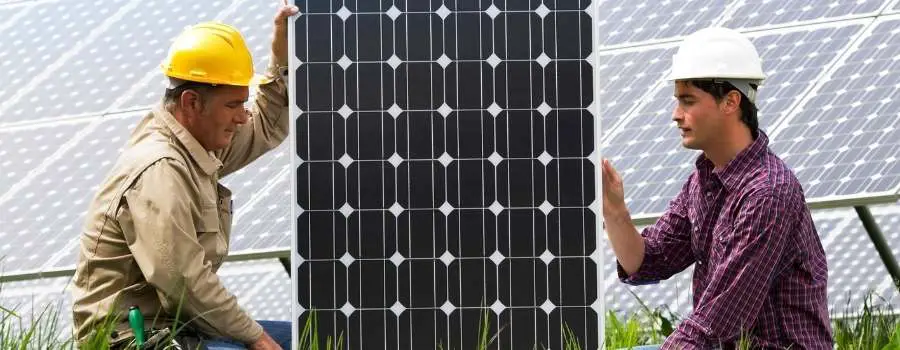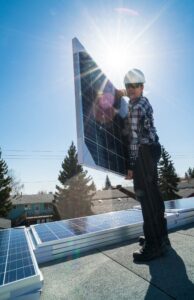
So you’ve decided to take the plunge and invest in solar panels for your home. That’s great…you’re already saving money on electricity bills, reducing your carbon footprint, and helping the environment.
One thing many solar investors don’t always consider is transporting…whether from a store to your home or from one home to another. Granted, when you have a solar array installed the installation company will do the transporting…but if you are a “do-it-yourselfer” and only dealing with a few panels, then you may want to check out some of the following helpful hints!
How Do You Transport Solar Panels?
In general, solar panels should be transported by placing them vertically in sturdy packaging or onto pallets that have been based with a layer of heavy duty cardboard. Corner protectors and padding, such as blankets or foam, should be placed between each panel.
Solar panels are expensive, extremely delicate, and are very susceptible to damage. Currently there is no globally widely accepted standard for the packaging, loading, transport, and unloading of solar panels. Therefore, it is always important to check directly with the shipping company to see if they have any specific requirements for transport.
Although there is no 100% fail-proof way to transport them, there are steps that you can take to minimize the risk of damage as much as possible. Before shipping, all panels and pallets should be inspected for any signs of damage.
Solar panels can be packed on pallets either horizontally or vertically in boxes or on pallets, although it is always preferable to stack vertically to reduce risk of cracking. Generally, around 28-30 panels can be packed per pallet depending on their size.
Two layers of corrugated cardboard underlayment should be placed on the pallet to protect against any scratches. The first layer of solar panels should be placed “sunny side” down on top of the cardboard.
Cardboard, foam, or plastic separators are then placed between each layer of panels to reduce pressure. Foam pads are ideal because they offer the best protection against vibration damage and it is recommended to use a separator with at least 3mm of uncompressed thickness. Corner protectors and foam pads are placed around the corners, as the edges and corners are the most vulnerable to damage.
The top layer of solar panels should be placed “sunny side” facing up. Once all of the panels are loaded, the shipment is then wrapped in stretch foil. Pallets of solar panels are then banded to secure the shipment. The pallet should only be strapped around the edges, never in the middle to protect against cracking.
The package should then be labelled on two sides with the following pictorial labels: “Do Not Stack”, “Keep Dry”, “This Way Up”, “Fragile”, and “Do Not Tilt”. Cardboard pyramids can also be placed on top of the pallet to prevent workers from stacking additional pallets on top.
In the industry, cardboard packaging is often used. This type of packaging can offer some protection, but can still allow for some mechanical stress. If cost allows, wooden crates are ideal for shipping solar panels as they allow a bit more protection.
How Do You Protect Solar Panels During Loading And Transport?
Although proper packaging of the solar panels can greatly reduce the risk of damage during transport, there are ways they can be damaged. Rough handling and loading, workers walking on pallets, improper lifting with forklifts, and stress vibrations from being driven on bumpy roads can all lead to damage.
Choosing a company experienced with shipping delicate items and using proper signage can assist with panels being damaged during shipping. Since solar panels are fairly common with homeowners now, most transport companies will be capable of moving them safely.
How Do I Transport A Solar Panel From The Store Or Warehouse?
In general, moving a few solar panels from a store to your home can be done with a little preparation. You will want a vehicle large enough so they can be laid flat or, better yet, vertically. Place some blankets between each panel and make sure they are braced snuggly so they don’t slide around.
If you are just ordering a couple solar panels, it may be the most cost-effective option to pick them up yourself from the store or warehouse. In this case, it is important to properly prep your vehicle for bringing them home.
Ensure that you prepare some form of packing material to cushion the panels to prevent cracking…foam pads, bubble wrap, or even blankets or old towels can be used to wrap around them.
Solar panels should never be strapped across the top of your vehicle as there is a greater risk of damage to both your vehicle and the solar panel. It is best to place them inside your car or van.

What Is The Best Way To Carry Solar Panels?
On average, a solar panel weighs around 40 pounds and should be carried by two people one each corner. Ideally, you will want to wrap your panel in blankets and use a hand truck for transport to the vehicle or installation site.
Although 40 pounds is not an enormous amount of weight for one person to carry, due to its awkward shape, size, and fragile nature it is advisable to not carry them too far without the help of another person. Each person should carry the panel by holding each corner.
When carrying a solar panel by yourself, try not to put too much pressure in one area. The best way to carry it is to distribute the weight across your back, arm, and shoulders.
Can You Ship Solar Panels?
Typically, solar panels can be shipped but not through the US Postal Service. Solar panels are are fairly delicate and expensive, yet still weigh between 30-55 pounds, therefore panels will have to be shipped via trucking, rail, air, or ocean freight.
LTL (less than truckload) services can be used when you only have a couple of pallets of panels, while FTL (full truckload) can be used when you are shipping enough panels to fill an entire truck.
For longer distances, multimodal shipping can be used which combines two or more methods of shipping to get your solar panels to the desired destination.
How Much Does It Cost To Ship Solar Panels?
On average, it will cost $700 to ship a pallet of solar panels from the West coast of the United States to the East Coast. Dimensions of the shipment, shipping method, destination, and additional services required can vary this cost.
Since solar panels cannot be shipped through regular mail, most times a smaller order will be shipped LTL (less than truckload). In general, this method means that shipping will cost more because it is not as efficient and more people are involved in the shipping process.
It is always best to contact a few freight companies to get a quote for your specific shipping needs. However, for a rough example of how much it might cost, to freight ship one pallet of solar panels (24-32 panels) from a warehouse located in California, it would cost approximately $200 to ship to a location in the west coast and up to $700 to the east coast.
Can You Stack Solar Panels For Transport?
In general, solar panels can be stacked for transport as long as they are properly packaged. You will want them stacked with the “sun-side” up and have layers of foam or cardboard between each layer. Nothing else should be stacked on top of the panel and the stack itself should not be that high.
When solar panels are stacked horizontally without proper care, it can cause small microcracks that are not visible to the eye. These small cracks can greatly reduce the effectiveness of how well the panel operates and its total lifespan.
Cardboard, foam, or plastic separators should always be used for horizontal stacking to reduce some of the pressure. However, most available separators do not protect the panels from mechanical stresses. The cardboard and plastic separators are not strong and wide enough to sufficiently separate the panels from each other – thus the top panels cause weight stress on the panels on the bottom.
The “stiletto effect” creates microcrackers, which occurs when hundreds of pounds of weight presses on the corners of the bottom panels. Due to these factors, it is always preferable to stack them vertically to minimize the risks of weight stress and top-to-bottom pressure.
Never the less, some clients may require solar panels to be stacked horizontally in order to save the cost and time associated with unpacking them. In this case, the best thing to do to use lots of buffer materials around each panel to minimize the risk of damage.
Final Thoughts
If you are doing a full solar array install on your home…or even a smaller home like a cabin…I highly recommend using a professional company to do the moving. They will be insured, have experience, and most importantly have the extra hands and equipment for such moves.
However, if you are only moving a few panels for…say a shed or garage…then you shouldn’t’t have any trouble as long as you take the proper precautions and don’t try to skimp on proper protection. You probably have most of this stuff handy, but here is a list with a few affiliate links you may want to check out:
- Foam Pads
- Bubble Wrap
- Corner Protectors
- Shrink Wrap
- Moving Blankets
- Hand Truck
